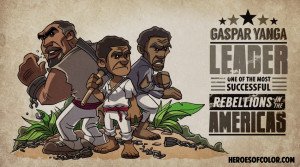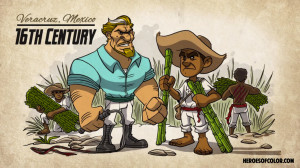Abraham Lincoln. George Washington. John F. Kennedy. Martin Luther King, Jr. Barack Obama. Albert Einstein. Isaac Newton. Neil Armstrong. These historic figures, their accomplishments, and their impact on the history of our world, have long been chronicled throughout various forms of media.
Yet, while their remarkable lives and achievements have already become part of today’s educational curriculum, there are countless others whose feats have been all but forgotten by the public. Many of those were accomplished by people of color; men and women who all have contributed significantly to our society – sometimes in ways we may not be aware of.
Making people aware of those influential, yet otherwise obscure individuals, and their lasting contributions to society, is the mission of David Heredia, the creator, writer and illustrator of the new animated educational series HEROES OF COLOR. Its first 2 episodes is now streaming via its official web site and Youtube page, and a Crowdrise campaign to help fund production of an additional 24 episodes is underway. (See links to all below).
 The series’ first season launched with the incredible story of the military corps known as “The Harlem Hellfighters” – the U.S. Army’s 369th Regiment, who won worldwide honors for their bravery in World War I, while being forced to fight separately from their white counterparts.
The series’ first season launched with the incredible story of the military corps known as “The Harlem Hellfighters” – the U.S. Army’s 369th Regiment, who won worldwide honors for their bravery in World War I, while being forced to fight separately from their white counterparts.
Its second episode chronicles the exploits of Gaspar Yanga, a former slave who, in 1570, led his followers to freedom through one of history’s greatest rebellions.
Since its debut, HEROES OF COLOR has won both awards from several film festivals, along with the praise and endorsements of prominent African-American leaders such as U.S. Congressman Charles Rangel of New York, Harvard historian Dr. Henry Louis Gates, and Joe Dillard, who at age 26, made history by becoming the youngest man to head a chapter of the NAACP (National Association For The Advancement of Colored People) when he became President of its Norfolk, Virginia branch.
Each episode of HEROES OF COLOR combines the popular “whiteboard” hand-drawn animation aesthetic that’s become popular in various TV series and online videos, plus thoroughly researched historical information and insightful voiceover narration (by Aaron Boykin) that effectively tells the stories of the accomplishments and legacies of the figures discussed throughout the series.
With the constant flow of negative news stories about police shootings and violence against African-Americans and other minorities, the never-ending discrimination that they continue to face, and the stereotypes that have long been perpetuated against them in the media, Heredia knew how crucial it was to show people of all ages – especially children, including his own – a positive view of men and women of color in our society. It was that mission he sought to accomplish by creating HEROES OF COLOR.

David Heredia, creator of the new educational animated series HEROES OF COLOR, now streaming its first 2 episodes on its official web site and Youtube pages.
“When I created this project, I did it first to show my son that there are black superheroes. When my research turned up only a handful, I turned to real life heroes,” he says. “I did it because I want him to be proud of our Afro-Latino ancestry. Once the video (of the first episode) got out, the responses that I got from the public just opened my mind to the new possibilities of educating through art. Viewers can expect to be inspired, just as my son did.”
Just as important for Heredia was bringing viewers a series that celebrates the lives and achievements of people from all ethnicities and backgrounds. Through HEROES OF COLOR, Heredia seeks to smash the all too common stereotypes that minorities have been associated with – both in real life and mainstream media.
“I got tired of the constant portrayal of an inferior race of thugs, thieves and slaves. I’m tired of having our incredible history buried on purpose,” adds Heredia, who also hopes that HEROES OF COLOR will encourage viewers to embrace their own racial heritage. “It’s important for all people to understand that having pride in your race and culture does not automatically equal the hatred of other races and cultures.”
Before a single episode appears online, though, Heredia starts the production process for HEROES OF COLOR by extensively researching whatever materials can be found on the people whose stories he’ll be telling in each episode. “Once I’ve pinned down a hero I want to focus on, I write down bullet points of their life from all of the resources I have gathered,” he explains.
Of course, putting it all together into a compact, yet effective webisode is perhaps the biggest task Heredia faces when working on HEROES OF COLOR. “My biggest challenge, however, is trying to get the life and accomplishments of one person into a three minute video. This series is intended to make an introduction to the person.”
Since many of their own triumphs have been all but forgotten, and since online resources like Wikipedia aren’t always trustworthy, finding accurate information on the figures presented in HEROES OF COLOR was a constant challenge for Heredia. “There were several websites that were just copying and pasting the exact same articles, which were loaded with wrong information,” says Heredia. “So, going to the library and trying to dig up as much credible resources as possible has become a regular occurrence.”
 After compiling each of the historical photos and text materials during the research phase, Heredia then begins working on the script for each episode of HEROES OF COLOR.
After compiling each of the historical photos and text materials during the research phase, Heredia then begins working on the script for each episode of HEROES OF COLOR.
“I check and recheck my facts. When I’m done with the bullet pointed list of events, I’m somewhere around 1500 words,” he says. “Then, I get it down to a 500-600 word range to equal a three minute piece. Sounds easy, but the challenge is in making it sound like an entertaining script, and not a school paper.”
Then comes the task of putting words, sight and sound together into a compact, yet effective package. After editing the final voiceover copy with script editor Michael Hagerman, and recording the script with narrator Aaron Boykin, the final element of HEROES OF COLOR comes together as Heredia uses both photos and written info compiled during his research to help him create the animated visual portion of each episode.
“Once I get the audio back, I start breaking up the script into chunks that I want to focus on illustrating. This makes it easier to draw up some preliminary storyboards,” Heredia says, describing his work on animating HEROES OF COLOR. “Once the storyboards are completed, I begin cleaning up the boards and start the animation process. The majority of the work goes into everything you do before you actually start animating! My Lord, it’s a lot of work.”
While Heredia has been hard at work on writing future episodes of HEROES OF COLOR, including one that will run 6 minutes total, he believes that viewers of his series have much to gain, and much that they can be proud of, by learning about the lives, achievements and influence that people of color have given to our world.
“It will benefit viewers the way it has benefited my kids (through) representation. Seeing yourself represented as a hero fills you with pride and confidence,” Heredia says. “To see glorious stories of how we overcame tough situations over, and over, and over again with nothing more than dogged persistence, and a desire to succeed, is inspiring.”
Furthermore, he hopes that HEROES OF COLOR will become an important resource for educators and historians. “I want to see it in the classrooms, without a doubt. Beyond the classrooms, I would like this series to be featured on READING RAINBOW, PBS and The History Channel,” Heredia remarks. “I think it needs to be a part of a nationwide exhibition from the Smithsonian, the (New York) Schomburg Center for Research In Black Culture, and other cultural museums.”
 The process of creating HEROES OF COLOR has also made quite an impact on Heredia as an animator, filmmaker and historian.
The process of creating HEROES OF COLOR has also made quite an impact on Heredia as an animator, filmmaker and historian.
“HEROES OF COLOR has taught me the importance of not letting others dictate what my vision is,” he responds. “Everyone will have an opinion of the work that you do. Someone may be inspired by it, while someone else will only look for flaws in your execution. Hang around positive people, not haters.”
To that end, Heredia offers words of encouragement for future filmmakers that want to create meaningful educational content of their own. “Join clubs, contests, festivals and immerse yourself totally in your project. Surround yourself with creative people who have more experience than you. Believe in yourself and in your vision.”
Just as those stories have given his children a strong sense of pride, he especially hopes that the series will instill the same in everyone who watches – regardless of race, ethnicity or background. “I want to inspire people of color to be proud of who they are, and to know that they are and continue to be valuable assets to society,” says Heredia. “Racism is a mental disease and one of the symptoms is the belief that the color of a person’s skin dictates the level of intelligence they have.”
NOTE: Regarding closed-captioning/subtitling of HEROES OF COLOR, Heredia says: “There aren’t any immediate plans to do that, but it sounds like an amazing idea once I am able to secure some funding.”
Episode 2 of HEROES OF COLOR, featuring the story of Gaspar Yanga, can be viewed here:
To contribute to HEROES OF COLOR’s CrowdRise crowd funding campaign, visit:
http://www.crowdrise.com/heroes-of-color-fundraiser/fundraiser/davidheredia
ON THE WEB: www.heroesofcolor.com
YOUTUBE: https://www.youtube.com/channel/UCgJN0llTuMT5FosMlj3BawA
TWITTER: https://twitter.com/herediadesigns













No Comment